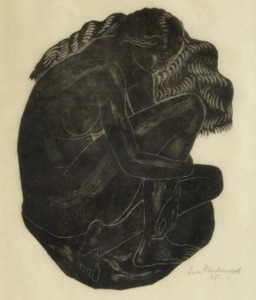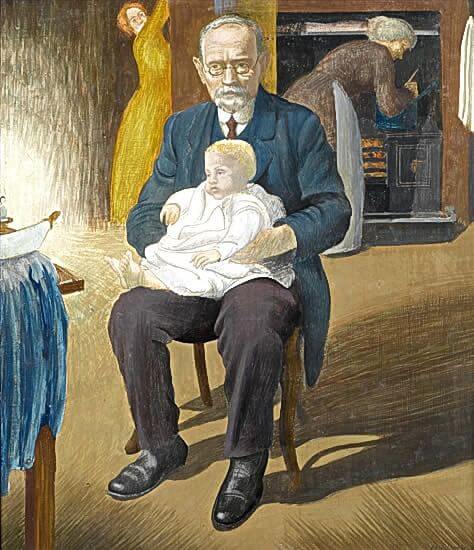Leon Underwood (1890 - 1975)
£5,750
Original woodblock

Size:
Height – 17.8cm
Width – 14.8cm
1 in stock
Literature: Llewellyn, Sacha, and Paul Liss. Portrait of an Artist. Liss Llewellyn, 2021, p.118.
This original woodblock was given by Underwood to Margaret Bruce (1909-98), his studio assistant. Bruce trained at the Glasgow School of Art, 1928-32, and in the following year enrolled at the Brook Green School of Art; two years after this she became studio stooge’, ie studio assistant, to Leon Underwood, and worked there until WW2, maintaining a friendship with him for the rest of his life.
Having produced etchings during his time at the Slade and in the early 1920s, Underwood had began to produce wood engravings in around 1924 at the same time as his early experiments with stone carving – the act of carving in relief the wood block is a continuation of his direct carving. At his Brook Green School Underwood offered an alternative art training to some of the most gifted artists of the inter-war generation, including Henry Moore, Eileen Agar, Blair Hughes-Stanton, and Gertrude Hermes. With a focus on experimental life drawing, the School was also a focus for experimental printmaking, after one of his pupils introduced a multiple line engraving tool called a velo which enabled them to achieve unusual visual effects in their wood engravings.
In 1925 Underwood and his pupils were to form the English Wood Engraving Society, reflecting the fact that their progressive imagery was at odds with the nostalgic work of many pastoral engravers of the same period. The following year Underwood moved to New York, where he set up a private drawing school in Greenwich Village and worked as an illustrator for publications including Vanity Fair and The New Yorker and illustrated several books, including his own Animalia and illustrated novel The Siamese Cat.
We are grateful to Simon Lawrence for assistance

Sculptor, printmaker, painter, designer, writer and teacher, born in London. Studied from 1907-10 at Regent Street Polytechnic School of Art under Percival Gaskell, then a scolarship took him to Royal College of Art, 1910-13, where he was taught painting partly by Gerald Moira. After World War I service in Royal Engineers Camouflage Section, Underwood completed commissioned pictures for Imperial War Museum. From 1919-20 enrolled for year’s refresher course at Slade School of Fine Art, almost exclusively life drawing under Henry Tonks. In 1921 opened Brook Green School, started on two years of constant printmarking and began first major painting, Venus in Kensington Gardens. From 1920 Unerwood had been teaching life drawing at Royal College of Art, but in 1923 he resigned and went to Paris and Iceland on a Rome Prize grant. By then he had had first one-man show at Chenil Galleries, 1922. The 1920s were busy for Underwood: he travelled extensively, notably in Mexico, studying Mayan and Aztec sculpture, and in Spain studying cave paintings; he illustrated a number of books, including his own novel The Cat, with woodcut illustrations; exhibited widely; taught drawing at St Martin’s School of Art; and in 1931 founded and published the magazine The island, to wich such artists as Henry Moore and Eileen Agar contributed. The 1930s saw intense sculpture activity, and in 1934 he published Art for Heaven’s Sake. In World War II Underwood served in Civil Defence Camouflage, 1939-42. After the war he visited West Africa, wrote several books on its art and did first oil paintings on African themes. From the 1950s Underwood was very busy with sculpture again and advocating his cycle of style theory and his use of optimistic subject matter. There was a first full-scale retrospective at The Minories, Colchester, in 1969; the exhibition Mexico and After took place at National Museum of Wales, Cardiff, in 1979; and the Redfern Gallery organised a show in 2004. Tate Gallery holds his work which has been among the most neglected of twentieth-century British art, especially the sculpture.